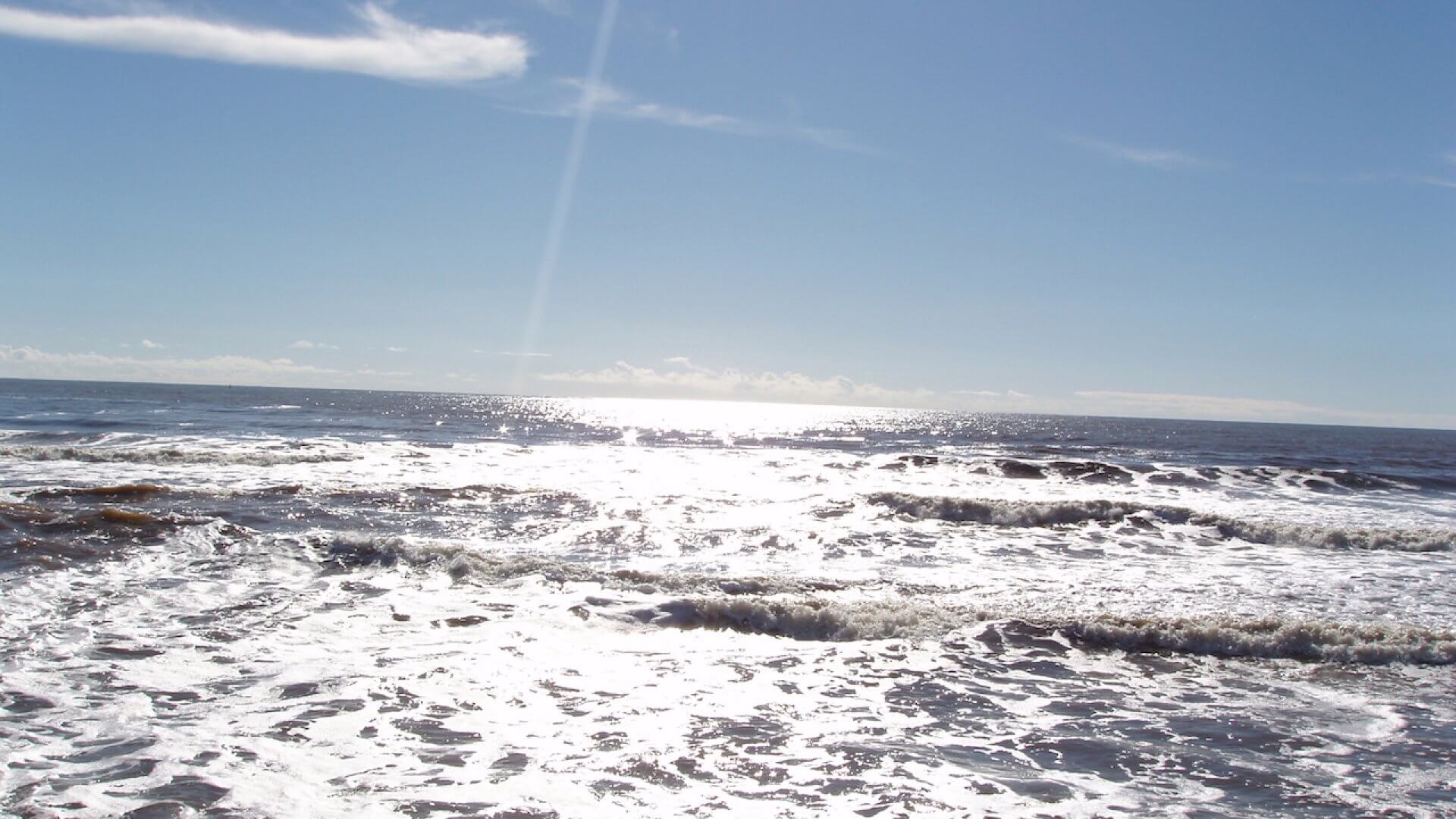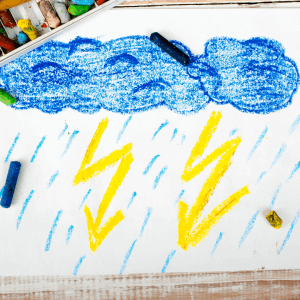It’s not unusual for a child to be fearful of thunderstorms. Thunderstorms can be intense and unpredictable. For some children fears of thunderstorms are just a passing phase. However for others, they can trigger a range of emotions in children, from anxiety to panic. The panic may be almost impossible to soothe. Furthermore, fears can last quite a while. Thunderstorm phobia is also called Astraphobia. Indeed, astraphobia is listed in the top 10 common childhood-specific phobias. It is estimated that around 5-12% of children experience a specific phobia.
As a parent, witnessing your child in this level of distress can be heartbreaking. However, with your support and some well-informed strategies, you can help your child gradually overcome their fear and build resilience. Here are some practical tips and insights to guide you on this journey.
Validate and Normalize Their Feelings
To begin, the first step in helping your child cope with their thunderstorm phobia is to acknowledge their feelings. Never belittle or dismiss their fear. Resist the urge to say, “You don’t need to worry about the storm.” or “The storm is nothing to worry about.” It can be very confusing to children when their body tells them one thing but adults are telling them something else. Instead, validate their emotions and reassure them that their feelings are natural. Explain that many people, including adults, feel scared or uncomfortable during thunderstorms.
Educate about Thunderstorms
Knowledge is a powerful tool in combating fear. Educate your child about thunderstorms. What causes them, why lightning occurs, and the science behind thunder. Use age-appropriate books, videos, or simple discussions. The goal is to help them understand what thunderstorms are and what they are not. Children may have their own fantasies about what the loud noise means or the lightning flash. Teaching them how to count the second between thunder and lightning can even give them a sense of control. This can give them the power to determine if the storm is getting closer or farther away. You can also discuss real-world ways weather is harnessed for positive use. Check out some of these great resources for learning about thunderstorms:
Model Brave Behavior
Children often learn from observing their parents’ reactions. Stay calm and composed during thunderstorms to model healthy behavior for your child. Share how you cope with your own anxieties and discuss the strategies you use. This not only normalizes fear but also demonstrates that it’s possible to manage it.
Create a Safe Environment
Creating a safe environment can happen in two ways. First, share with your child the ways that you protect your family from thunderstorms. For example, you may put away loose furniture outside if the winds are high. You probably close all the windows. Perhaps you keep flashlights and candles nearby. It can help to make this playful by saying something like “Who can find the flashlights?”. Then everyone can race to find their flashlight. Practice being in the dark by having everyone turn on their flashlights. Allow your child to turn off the lights. This can give them a sense of control regarding what to do in a storm.
The second way of thinking about creating a safe environment is having a special place. Designate a safe space where your child can retreat during thunderstorms. This can be their bedroom, a cozy corner, or even a makeshift fort. Make this space comforting by adding their favorite items (i.e. blankets, stuffed animals, and books). One family I know included a lavender essential oil roll-on to promote relaxation. Encourage them to use this safe space whenever they feel anxious, giving them a sense of control.
Relaxation Techniques
Teach your child relaxation techniques to manage their anxiety during thunderstorms. Deep breathing exercises, progressive muscle relaxation, and guided imagery can be effective tools. An enjoyable one for young children is to draw a picture of a flower. (Or grab one in real life.) Next, draw a candle. (Or find one at home. No need to light it) Have your child breathe in nice and slow as if to smell the flower. Hold the beautiful smell. Then blow the candle out nice and slowly. A great muscle relaxation activity for kids is to pretend they are an uncooked noodle. They are stiff and can’t bend. Then they are a cooked noodle, loose and wiggly to the ground. Finally, there are wonderful YouTube videos that illustrate Tapping. This can be a powerful anxiety reduction technique. Model and practice these techniques during calm moments. Practice will make it easier for your child to implement them when they’re feeling anxious.
Foster Positive Associations
Turn thunderstorms into an opportunity for bonding and positive experiences. Create traditions like making popcorn, building a fort, or watching a movie during storms. Get dollar store glow sticks that only come out in thunderstorms. Have a loud dance party. Use the pots and pans as drums. But make it fun. Extra points if it’s an activity they can only do when there is a storm. Associating thunderstorms with enjoyable special activities can gradually shift your child’s perception from fear to something to look forward to.
Provide Distractions
Engaging your child in distracting activities can help divert their attention from the fear. While this is similar to the above tip, it is different in that the goal is shifting attention. In the previous tip, the goal is potentially getting your child to see a storm as something to look forward to. Distractions can be anything that will get their mind off the storm. For some children, this may be strictly keeping to their routine so there is no time to dwell on the storm. For others, it may involve playing a game, baking a cake, or working on a craft project together.
Avoid Reinforcing the Fear
Though it’s natural to comfort a fearful child, avoid constant reassurance during thunderstorms. This can unintentionally reinforce their fear by implying that their anxiety is warranted. This may seem counter to validating their feelings. In contrast, you want to acknowledge and validate their fear without reinforcing a need to be afraid. For example, you might say, “It makes sense to be afraid. The storm is loud and the wind is blowing the trees. But we are safe in the house. The house will protect us from the storm.” Be careful about saying, “Oh no, a storm is here, you better come close to mommy. Mommy will protect you.” While this may be harmless in many situations, it may reinforce that the anxious child needs to be close to you whenever there is a storm. Or that only you can keep them safe.
Furthermore, be mindful of when children are excessively seeking reassurance. Perhaps they keep asking, “The storm can’t get me???” or “Did you close all the windows?” This repetitive questioning may be a sign they are using your answer as a way to decrease their anxiety. Or that their need for reassurance is becoming a compulsion. Compulsions provide temporary relief but are self-reinforcing. Worry about the storm → asking for reassurance → getting reassurance → anxiety reduction → worry returns and the cycle continues. In these situations, facing the fear becomes most important.
For many children the above strategies may be enough to get them through a phase of being afraid of thunderstorms. For other children, you may need a more coordinated approach.
Gradual Exposure aka Facing the Fear
Exposure, done in a controlled and gradual manner, can be highly effective in overcoming phobias. First, get your child hyped up for conquering their fear. Plan how you will celebrate each of their accomplishments.
Identify Safety Behaviors
It’s common for children facing phobias to develop safety behaviors. Safety behaviors are actions taken to feel secure during anxious moments. While these may provide temporary relief, they can also reinforce the fear. Recognize any safety behaviors your child may exhibit during thunderstorms. These might include hiding under blankets, avoiding certain rooms, or re-checking windows. Instead of discouraging these behaviors outright, work with your child to gradually reduce reliance on them.
Work with your child to begin gradual exposures while reducing safety behaviors. Create a list with your child, also known as a hierarchy. Your child’s list might look like this.
- Sing songs about thunder (I recommend Imagine Dragons Thunder).
- Read books about storms.
- Draw pictures with lightning.
- Listen to audio recording of thunderstorms.
- Watch thunderstorm videos.
- Don’t hide under covers during a storm.
- Only check the windows once.
- Go into the sunroom during a storm (if previously avoided).
- Watch lightning from the window.
- Step out into a mild storm (always prioritize safety).
- Step out into a more intense storm (always prioritize safety).
Exposures to storms may happen in a way that is not planned. You may get caught on the way home from school. If your child is ready, you might encourage them to use the moment as an unplanned exposure to face their fear.
Each step in the right direction should be celebrated. If your child can get through listening to audio of thunderstorms, celebrate by letting them have a reward of their choice. Maybe they get to pick dinner. Maybe they can stay up 15 minutes later on a Saturday night. It is ok if they aren’t quite able to finish a step. You want to let them know you are proud of their effort. And they can try again next time. You can then consider a half step.
Watch their confidence grow as they conquer their fear bit by bit. This gradual approach helps your child build confidence and resilience in the face of their fears. As a result, it reduces the need for safety behaviors.
Seek Professional Help
If your child’s astraphobia significantly interferes with their daily life and persists over time, consider seeking professional help. A NJ child psychologist or child therapist experienced in treating phobias in NJ can provide specialized guidance and techniques tailored to your child’s needs. NJ therapists who specialize in child anxiety understand how to set up gradual exposure in children to help them tap into their bravery. They will also coach you on the best way to encourage your child. Moreover, they will provide direction on how to not inadvertently reinforce the fear.
Helping a child overcome their fear of thunderstorms requires patience, understanding, and a strategic approach. By acknowledging their feelings, providing education, and gradually exposing them to thunderstorms, you can empower your child to manage their anxieties and build resilience. Remember, every child is unique, and progress may be slow, but with your unwavering support, they can conquer their fear and develop lifelong coping skills.
Get Started With Child Therapy in New Jersey Today!
Astrophobia can be difficult to manage. Finding ways as a parent to help educate your child on thunderstorms Indeed, a child therapist can provide practical tips to help you understand the importance of play for a child with anxiety. Our child therapists in Branchburg, NJ, and Scotch Plains, NJ understand the importance of parent involvement. To ensure that you have the parenting support you need and deserve, and to begin therapy for your child, follow these steps:
- Connect with Brave Minds Psychological Services today for a free 20-minute consultation.
- Get your questions answered by one of our experienced therapists.
- Begin feeling more hopeful as a parent.
Other Counseling Services at Brave Minds Psychological Services
At Brave Minds Psychological Services, we offer a variety of services from our licensed therapists in order to get you on the right path to healing. Our other services include child sexual abuse therapy and food allergy therapy. For teens, we provide anxiety treatment for teens, and teen social phobia therapy. We also specialize in adult anxiety counseling, postpartum counseling, birth trauma therapy, and sexual assault counseling for adults. Other offerings include online therapy, group therapy, couples counseling, and counseling for parents.
Futhermore, we also have a blog where we write about a wealth of different mental health subjects. If you’re interested in learning more about us here at Brave Minds Psychological Services, please reach out at our Scotch Plains and Branchburg counseling offices!







